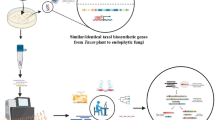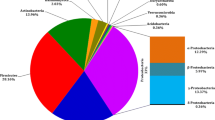Abstract
The basis of chemical crosstalk in plants and associated endophytes lies in certain so-called communication molecules that are responsible for plant-microbe and microbe-microbe interactions. Consequently, elucidating the factors that affect the nature, distribution, and amount of these molecules and how they impact the interaction among endophytes and associated organisms is essential to understand the true potential of endophytes. In the present study, we report the discovery of nine hexacyclopeptides from an endophytic fungus, Fusarium solani, isolated from the bulb of Narcissus tazetta, and their selective accumulation by an endophytic bacterium, Achromobacter xylosoxidans isolated from the same tissue. We used matrix-assisted laser desorption ionization imaging high-resolution mass spectrometry (MALDI-imaging-HRMS) to firstly identify and visualize the spatial distribution of the hexacyclopeptides produced by endophytic F. solani. After culture condition optimization, their sequence was identified to be cyclo((Hyp or Dhp)-Xle-Xle-(Ala or Val)-Thr-Xle) (Dhp: dehydroproline) by the characteristic a, b, or y ions using liquid chromatography tandem mass spectrometry (LC-HRMSn). These hexacyclopeptides were confirmed to be fungal biosynthetic products by deuterium labeling experiments. Finally, in order to understand the plausible ecological relevance of one or more of the discovered hexacyclopeptides within the contexts of microbial “neighbor communication,” we devised a dual-culture setup to visualize using MALDI-imaging-HRMS how the hexacyclopeptides released by the endophytic fungus are accumulated by another endophytic bacterium, A. xylosoxidans, isolated from the same bulb tissue. This work exemplifies the relevance of cyclopeptides in endophyte-endophyte interspecies neighbor communication occurring in nature. Such communication strategies are evolved by coexisting endophytes to survive and function in their distinct ecological niches.









Similar content being viewed by others
References
Abdalla MA, Matasyoh JC (2014) Endophytes as producers of peptides: an overview about the recently discovered peptides from endophytic microbes. Nat Prod Bioprospect 4:257–270
Akram U, Azhar M, Akthar J, Kumar P, Fazil M, Ahmed S (2012) Narcissus tazetta—a case study of biopiracy. Curr Sci 103:978–979
Ali S, Charles TC, Glick BR (2014) Amelioration of high salinity stress damage by plant growth-promoting bacterial endophytes that contain ACC deaminase. Plant Physiol Biochem 80:160–167
Aly AH, Debbab A, Proksch P (2013) Fungal endophytes—secret producers of bioactive plant metabolites. Pharmazie 68:499–505
Armirotti A, Millo E, Damonte G (2007) How to discriminate between leucine and isoleucine by low energy ESI-TRAP MSn. J Am Soc Mass Spectrom 18:57–63
Bachmann BO, Van Lanen SG, Baltz RH (2014) Microbial genome mining for accelerated natural products discovery: is a renaissance in the making? J Ind Microbiol Biotechnol 41:175–184
Bode HB, Reimer D, Fuchs SW, Kirchner F, Dauth C, Kegler C, Lorenzen W, Brachmann AO, Grün P (2012) Determination of the absolute configuration of peptide natural products by using stable isotope labeling and mass spectrometry. Chem Eur J 18:2342–2348
D’Alessandro M, Erb M, Ton J, Brandenburg A, Karlen D, Zopfi J, Turlings TCJ (2014) Volatiles produced by soil-borne endophytic bacteria increase plant pathogen resistance and affect tritrophic interactions. Plant Cell Environ 37:813–826
Davidson SK, Allen SW, Lim GE, Anderson CM, Haygood MG (2001) Evidence for the biosynthesis of bryostatins by the bacterial symbiont “Candidatus Endobugula sertula” of the bryozoan Bugula neritina. Appl Environ Microbiol 67:4531–4537
Donia MS, Ruffner DE, Cao S, Schmidt EW (2011) Accessing the hidden majority of marine natural products through metagenomics. ChemBioChem 12:1230–1236
Esquenazi E, Yang YL, Watrous J, Gerwick WH, Dorrestein PC (2009) Imaging mass spectrometry of natural products. Nat Prod Rep 26:1521–1534
Feng MQ, Kang HP, Liu HM, Zhai CJ (2001) Chemical synthesis of DL-threonine. Hebei Keji Daxue Xuebao 22:22–24
Frederix M, Downie JA (2011) Quorum sensing: regulating the regulators. Adv Microb Physiol 58:23–80
Fu KL, Shen YH, Lu L, Li B, He YR, Li B, Yang XW, Su J, Liu RH, Zhang WD (2013) Two unusual rearranged flavan derivatives from Narcissus tazetta var. chinensis. Helv Chim Acta 96:338–344
Helfrich EJN, Reiter S, Piel J (2014) Recent advances in genome-based polyketide discovery. Curr Opin Biotechnol 29:107–115
Ho YN, Mathew DC, Hsiao SC, Shih CH, Chien MF, Chiang HM, Huang CC (2012) Selection and application of endophytic bacterium Achromobacter xylosoxidans strain F3B for improving phytoremediation of phenolic pollutants. J Hazard Mater 219–220:43–49
Kavroulakis N, Ntougias S, Zervakis GI, Ehaliotis C, Haralampidis K, Papadopoulou KK (2007) Role of ethylene in the protection of tomato plants against soil-borne fungal pathogens conferred by an endophytic Fusarium solani strain. J Exp Bot 58:3853–3864
Kusari S, Spiteller M (2011) Are we ready for industrial production of bioactive plant secondary metabolites utilizing endophytes? Nat Prod Rep 28:1203–1207
Kusari S, Lamshöft M, Zühlke S, Spiteller M (2008) An endophytic fungus from Hypericum perforatum that produces hypericin. J Nat Prod 71:159–162
Kusari S, Zühlke S, Spiteller M (2009) An endophytic fungus from Camptotheca acuminata that produces camptothecin and analogues. J Nat Prod 72:2–7
Kusari S, Zühlke S, Spiteller M (2011a) Effect of artificial reconstitution of the interaction between the plant Camptotheca acuminata and the fungal endophyte Fusarium solani on camptothecin biosynthesis. J Nat Prod 74:764–775
Kusari S, Zühlke S, Spiteller M (2011b) Correlations between camptothecin and related metabolites in Camptotheca acuminata reveal similar biosynthetic principles and in planta synergistic effects. Fitoterapia 82:497–507
Kusari S, Hertweck C, Spiteller M (2012a) Chemical ecology of endophytic fungi: origins of secondary metabolites. Chem Biol 19:792–798
Kusari S, Verma VC, Lamshöft M, Spiteller M (2012b) An endophytic fungus from Azadirachta indica A. Juss. that produces azadirachtin. World J Microbiol Biotechnol 28:1287–1294
Kusari S, Singh S, Jayabaskaran C (2014a) Biotechnological potential of plant-associated endophytic fungi: hope versus hype. Trends Biotechnol 32:297–303
Kusari P, Kusari S, Lamshöft M, Sezgin S, Spiteller M, Kayser O (2014b) Quorum quenching is an antivirulence strategy employed by endophytic bacteria. Appl Microbiol Biotechnol 98:7173–7183
Kusari S, Lamshöft M, Kusari P, Gottfried S, Zühlke S, Louven K, Hentschel U, Kayser O, Spiteller M (2014c) Endophytes are hidden producers of maytansine in Putterlickia roots. J Nat Prod 77:2577–2584
Letzel AC, Pidot SJ, Hertweck C (2013) A genomic approach to the cryptic secondary metabolome of the anaerobic world. Nat Prod Rep 30:392–428
Li T, Blande JD, Gundel PE, Helander M, Saikkonen K (2014) Epichloë endophytes alter inducible indirect defences in host grasses. PLoS ONE 9, e101331
Liu J, Li Y, Ren W, Hu WX (2006) Apoptosis of HL-60 cells induced by extracts from Narcissus tazetta var. chinensis. Cancer Lett 242:133–140
Ma LJ, Geiser DM, Proctor RH, Rooney AP, O’Donnell K, Trail F, Gardiner DM, Manners JM, Kazan K (2013) Fusarium pathogenomics. Annu Rev Microbiol 67:399–416
Márquez LM, Redman RS, Rodriguez RJ, Roossinck MJ (2007) A virus in a fungus in a plant: three-way symbiosis required for thermal tolerance. Science 315:513–515
Mithani A, Hein J, Preston GM (2011) Comparative analysis of metabolic networks provides insight into the evolution of plant pathogenic and nonpathogenic lifestyles in Pseudomonas. Mol Biol Evol 28:483–499
Molinski TF (2010) Microscale methodology for structure elucidation of natural products. Curr Opin Biotechnol 21:819–826
Mousa WK, Raizada MN (2013) The diversity of anti-microbial secondary metabolites produced by fungal endophytes: an interdisciplinary perspective. Front Microbiol 4:65
Navarro-Meléndez AL, Heil M (2014) Symptomless endophytic fungi suppress endogenous levels of salicylic acid and interact with the jasmonate-dependent indirect defense traits of their host, lima bean (Phaseolus lunatus). J Chem Ecol 40:816–825
Ola ARB, Thomy D, Lai D, Brötz-Oesterhelt H, Proksch P (2013) Inducing secondary metabolite production by the endophytic fungus Fusarium tricinctum through coculture with Bacillus subtilis. J Nat Prod 76:2094–2099
Piel J, Höfer I, Hui D (2004) Evidence for a symbiosis island involved in horizontal acquisition of pederin biosynthetic capabilities by the bacterial symbiont of Paederus fuscipes beetles. J Bacteriol 186:1280–1286
Reinhold-Hurek B, Hurek T (2011) Living inside plants: bacterial endophytes. Curr Opin Plant Biol 14:435–443
Rodriguez R, Redman R (2008) More than 400 million years of evolution and some plants still can’t make it on their own: plant stress tolerance via fungal symbiosis. J Exp Bot 59:1109–1114
Scherlach K, Hertweck C (2009) Triggering cryptic natural product biosynthesis in microorganisms. Org Biomol Chem 7:1753–1760
Scherlach K, Graupner K, Hertweck C (2013) Molecular bacteria-fungi interactions: effects on environment, food, and medicine. Annu Rev Microbiol 67:375–397
Schmidt EW, Nelson JT, Rasko DA, Sudek S, Eisen JA, Haygood MG, Ravel J (2005) Patellamide A and C biosynthesis by a microcin-like pathway in Prochloron didemni, the cyanobacterial symbiont of Lissoclinum patella. Proc Natl Acad Sci U S A 102:7315–7320
Schroeckh V, Scherlach K, Nützmann HW, Shelest E, Schmidt-Heck W, Schuemann J, Martin K, Hertweck C, Brakhage AA (2009) Biological sciences—microbiology. Proc Natl Acad Sci U S A 106:14558–14563
Shih CJ, Chen PY, Liaw CC, Lai YM, Yang YL (2014) Bringing microbial interactions to light using imaging mass spectrometry. Nat Prod Rep 31:739–755
Song MC, Kim EJ, Kim E, Rathwell K, Nam SJ, Yoon YJ (2014) Microbial biosynthesis of medicinally important plant secondary metabolites. Nat Prod Rep 31:1497–1509
Taga ME, Semmelhack JL, Bassler BL (2001) The LuxS-dependent autoinducer Al-2 controls the expression of an ABC transporter that functions in Al-2 uptake in Salmonella typhimurium. Mol Microbiol 42:777–793
Tan N-H, Zhou J (2006) Plant cyclopeptides. Chem Rev 106:840–895
Tanaka A, Christensen MJ, Takemoto D, Park P, Scott B (2006) Reactive oxygen species play a role in regulating a fungus–perennial ryegrass mutualistic interaction. Plant Cell 18:1052–1066
Trancassini M, Iebba V, Citerà N, Tuccio V, Magni A, Varesi P, De Biase RV, Totino V, Santangelo F, Gagliardi A, Schippa S (2014) Outbreak of Achromobacter xylosoxidans in an Italian cystic fibrosis center: genome variability, biofilm production, antibiotic resistance, and motility in isolated strains. Front Microbiol 5:article 138
Waller F, Achatz B, Baltruschat H, Fodor J, Becker K, Fisher M, Heier T, Hückelhoven R, Neumann C, von Wettsein D, Franken P, Kogel KH (2005) The endophytic fungus Piriformospora indica reprograms barley to salt-stress tolerance, disease resistance, and higher yield. Proc Natl Acad Sci U S A 102:13386–13391
Walsh CT, Fischbach MA (2010) Natural products version 2.0: connecting genes to molecules. J Am Chem Soc 132:2469–2493
White TJ, Bruns TD, Lee S, Taylor JW (1990) Amplification and direct sequencing of fungal rRNA genes for phylogenetics. In: Innis MA, Gelfand DH, Sninsky JJ, White TJ (eds) Protocols: a guide to methods and applications. PCR Academic press, San Diego, pp 315–322
Williams SM, Brodbelt JS (2004) MSn characterization of protonated cyclic peptides and metal complexes. J Am Soc Mass Spectrom 15:1039–1054
Wilson MC, Mori T, Rückert C, Uria AR, Helf MJ, Takada K, Gernert C, Steffens UAE, Heycke N, Schmitt S, Rinke C, Helfrich EJN, Brachmann AO, Gurgui C, Wakimoto T, Kracht M, Crüsemann M, Hentschel U, Abe I, Matsunaga S, Kalinowski J, Takeyama H, Piel J (2014) An environmental bacterial taxon with a large and distinct metabolic repertoire. Nature 506:58–62
Youk H, Lim WA (2014) Secreting and sensing the same molecule allows cells to achieve versatile social behaviors. Science 343:2142782
Zerikly M, Challis GL (2009) Strategies for the discovery of new natural products by genome mining. ChemBioChem 10:625–633
Zhao JT, Fu YJ, Luo M, Zu YG, Wang W, Zhao CJ, Gu CB (2012) Endophytic fungi from pigeon pea [Cajanus cajan (L.) Millsp.] produce antioxidant cajaninstilbene acid. J Agric Food Chem 60:4314–4319
Acknowledgments
We are grateful to the Ministry of Innovation, Science, Research and Technology of the State of North Rhine-Westphalia, Germany, and the German Research Foundation (DFG) for funding a MALDI-imaging high-resolution mass spectrometer. Wen-Xuan Wang gratefully acknowledges the China Scholarship Council (CSC) for a doctoral fellowship.
Conflict of Interest
The authors declare that they have no competing interests.
Author information
Authors and Affiliations
Corresponding authors
Additional information
This manuscript is dedicated with best wishes to Professor Dr. Ian Thomas Baldwin to honor his seminal contributions in the field of chemical and molecular ecology.
Electronic supplementary material
Below is the link to the electronic supplementary material.
ESM 1
(PDF 1014 kb)
Rights and permissions
About this article
Cite this article
Wang, WX., Kusari, S., Sezgin, S. et al. Hexacyclopeptides secreted by an endophytic fungus Fusarium solani N06 act as crosstalk molecules in Narcissus tazetta . Appl Microbiol Biotechnol 99, 7651–7662 (2015). https://doi.org/10.1007/s00253-015-6653-7
Received:
Revised:
Accepted:
Published:
Issue Date:
DOI: https://doi.org/10.1007/s00253-015-6653-7




